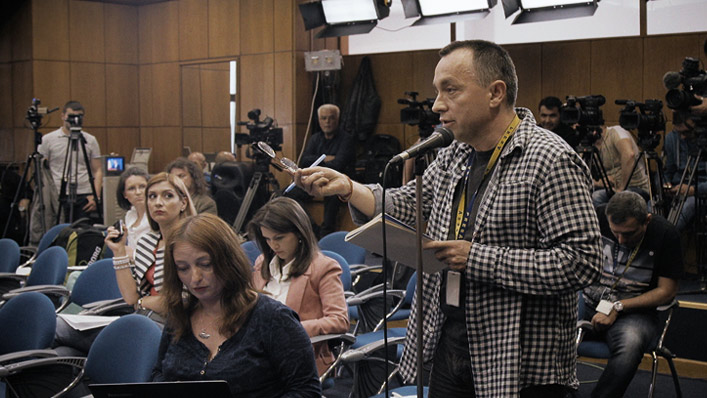Oscar-nominated documentary Collective follows a riveting and terrifying scandal

The Oscar-nominated Romanian documentary Collective is an eye-widening exposé that beggars belief. Here’s critic Luke Buckmaster’s review.
Goodness me: the Romanian documentary Collective—which is in the running for both Best Documentary and Best International Feature at this year’s Academy Awards—is an eye-opening experience. One of those exposés that make you gasp, shake your head and maybe mutter under your breath, beggaring belief that real events could be so twisted and terrible; that they could be mired not just in human carelessness but corruption and malfeasance. So yeah, nah: this isn’t the feel good movie of the year—but it is a very engrossing and quietly striking film about speaking truth to power.
See also:
* All new streaming movies & series
* Movies now playing in cinemas
* 10 documentaries we can’t wait to see in 2021
The expression “stranger than fiction” comes to mind, but feels almost cheap, almost distasteful, when it comes to explaining the core of it: an investigation into circumstances following a fire at a Bucharest nightclub in 2015, which left 27 people dead and 180 injured. We briefly see vision of the event via smartphone recordings, showing a band on stage performing (“fuck corruption!”, the lead singer hollers) followed by the sparks that created the blaze. Then running, screaming, pandemonium.
This tragedy is only the starting point for a larger story with wide implications, reaching from corridors of political power to the boardrooms of Big Pharma. There are initially puzzling turns of events: for instance following the fire, victims in hospital die after sustaining only minor injuries. Later—following mass protests—the Romanian government resigns (for Australians this is an almost alien concept: our ministers barely ever resign, no matter what new acts of moral turpitude they get busted for, let alone the government itself).
Stating this isn’t spoiling anything; it is declared in introductory text inserts. This text is significant not just in the obvious ways (setting a context) but through the absence of anything comparably didactic throughout the rest of the experience.
Presented in the ob-doc format, director Alexander Nanau (who was also the editor and cinematographer) follows a group of journalists doggedly pursuing the story not of the fire per se, but what it came to reveal—including that disinfectant used in Romanian hospitals had been secretly diluted and become useless. This resulted not only in people dying but dying with worms slithering around their wounds. The country’s Health Minister fronts the media and defends various processes but later resigns. A substantial chunk of the film’s second half follows his replacement, Vlad Voiculescu, who discovers the extent to which the system is broken.

It’s a strange and dramatic story with lots of nuances. The kind of tangled web that would benefit, in terms of convenient explanations, from a voice-over narration, perhaps articulated by journalist Cătălin Tolontan—who was instrumental in making sense of the farrago and unearthing the hospital disinfect fiasco. But Nanau goes the other way, true to the fly-on-wall observational model, leaving the impression that events speak for themselves.
They do—but they also take on meta qualities, as we follow the narrative through construction of its reportage. Observing journalists hover around television sets, watching news reports, it becomes apparent that there are three tiers of storytelling: the news broadcast they are watching; the film we are watching; and the story the journalists are in the process of writing. Without the safety net of voice-over narration, some detective work is required. We need to pay attention and keep track of things: to revelations; to conversations; to small details and big turning points.
Collective bears some similarity, subject-wise, to another recent documentary involving a literal fire: the riveting ABC series Exposed: The Ghost Train Fire. In the latter subjects address the interviewer, who is the camera by proxy; in Collective they converse with other people, ignoring the recording mechanisms in order for them to disappear for the viewer. Neither approach is ‘right’ or necessarily better—though the route Collective takes, shirking the convenience of talking heads, is more in line with the well-known proposition that films ought to “show, don’t tell.”
Having said that, people tell from inside the film, journalists for instance asking pointed questions or delivering potted summaries that provide anchors in the narrative. Which brings us back to those forward-moving meta qualities: the experience of watching a story while the story is being written.
Whereas The Ghost Train Fire is edited tight as a snare drum, sustaining interest to the very end (which no small feat given the format is three 90 minute episodes), Nanau’s documentary is freewheeling, intended to imitate the rhythms of daily life. The pace slips a little in the final stretch, if “pace” is even the correct word—given we’re not supposed to view the experience as something contrived to operate at a certain speed. It is, of course, but like “stranger than fiction”, the word doesn’t sit quite right—which is a testament to Collective‘s journalistic integrity. Again that integrity is tiered: a description of the film as well as its subjects.

















